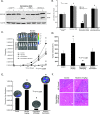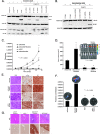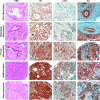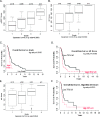Nicotine induces inhibitor of differentiation-1 in a Src-dependent pathway promoting metastasis and chemoresistance in pancreatic adenocarcinoma
- PMID: 23308043
- PMCID: PMC3540937
- DOI: 10.1593/neo.121044
Nicotine induces inhibitor of differentiation-1 in a Src-dependent pathway promoting metastasis and chemoresistance in pancreatic adenocarcinoma
Abstract
Smoking is a significant risk factor for pancreatic cancer, but the molecular mechanisms by which tobacco smoke components promote the growth and progression of these cancers are not fully understood. While nicotine, the addictive component of tobacco smoke, is not a carcinogen, it has been shown to promote the growth of non-small cell lung and pancreatic cancers in a receptor-dependent fashion. Here, we show that stimulation of pancreatic cancer cells with nicotine concentrations that are within the range of human exposure results in activation of Src kinase, which facilitated the induction of the inhibitor of differentiation-1 (Id1) transcription factor. Depletion of Id1 prevented nicotine-mediated induction of proliferation and invasion of pancreatic cancer cells, indicating that it is a major mediator of nicotine function. Nicotine could promote the growth and metastasis of pancreatic cancers orthotopically implanted into SCID mice; in addition, cells stably expressing a short hairpin RNA for Id1 did not grow or metastasize in response to nicotine. Nicotine could also confer resistance to apoptosis induced by gemcitabine in pancreatic cancer cells in vitro and depletion of Src or Id1 rendered the cells sensitive to gemcitabine. Further, nicotine could effectively inhibit the chemotherapeutic effects of gemcitabine on pancreatic tumors xenografted into mice. Clinical analyses of resected pancreatic cancer specimens demonstrated a statistically significant correlation between Id1 expression and phospho-Src, tumor grade/differentiation, and worsening overall patient survival. These results demonstrate that exposure to tobacco smoke components might promote pancreatic cancer progression, metastasis, and chemoresistance and highlight the role of Id1 in these processes.
Figures







Similar articles
-
Nicotine Reduces Survival via Augmentation of Paracrine HGF-MET Signaling in the Pancreatic Cancer Microenvironment.Clin Cancer Res. 2016 Apr 1;22(7):1787-99. doi: 10.1158/1078-0432.CCR-15-1256. Epub 2015 Dec 14. Clin Cancer Res. 2016. PMID: 26667487 Free PMC article.
-
ID1 facilitates the growth and metastasis of non-small cell lung cancer in response to nicotinic acetylcholine receptor and epidermal growth factor receptor signaling.Mol Cell Biol. 2011 Jul;31(14):3052-67. doi: 10.1128/MCB.01311-10. Epub 2011 May 23. Mol Cell Biol. 2011. PMID: 21606196 Free PMC article.
-
Inhibition of SRC tyrosine kinase impairs inherent and acquired gemcitabine resistance in human pancreatic adenocarcinoma cells.Clin Cancer Res. 2004 Apr 1;10(7):2307-18. doi: 10.1158/1078-0432.ccr-1183-3. Clin Cancer Res. 2004. PMID: 15073106
-
Gemcitabine: metabolism and molecular mechanisms of action, sensitivity and chemoresistance in pancreatic cancer.Eur J Pharmacol. 2014 Oct 15;741:8-16. doi: 10.1016/j.ejphar.2014.07.041. Epub 2014 Jul 30. Eur J Pharmacol. 2014. PMID: 25084222 Review.
-
Cholesterol metabolism in pancreatic cancer and associated therapeutic strategies.Biochim Biophys Acta Mol Cell Biol Lipids. 2025 Mar;1870(2):159578. doi: 10.1016/j.bbalip.2024.159578. Epub 2024 Nov 13. Biochim Biophys Acta Mol Cell Biol Lipids. 2025. PMID: 39542394 Review.
Cited by
-
Baicalein Inhibits Orthotopic Human Non-Small Cell Lung Cancer Xenografts via Src/Id1 Pathway.Evid Based Complement Alternat Med. 2019 Mar 4;2019:9806062. doi: 10.1155/2019/9806062. eCollection 2019. Evid Based Complement Alternat Med. 2019. PMID: 30949224 Free PMC article.
-
The addition of erlotinib to gemcitabine and cisplatin does not appear to improve median survival in metastatic pancreatic cancer.Invest New Drugs. 2013 Oct;31(5):1375-83. doi: 10.1007/s10637-013-9967-2. Epub 2013 May 4. Invest New Drugs. 2013. PMID: 23645398
-
Alpha 7-nicotinic acetylcholine receptor mediates the sensitivity of gastric cancer cells to 5-fluorouracil.Tumour Biol. 2015 Dec;36(12):9537-44. doi: 10.1007/s13277-015-3668-8. Epub 2015 Jul 3. Tumour Biol. 2015. PMID: 26136123
-
Nicotine exposure potentiates lung tumorigenesis by perturbing cellular surveillance.Br J Cancer. 2020 Mar;122(6):904-911. doi: 10.1038/s41416-020-0730-0. Epub 2020 Jan 31. Br J Cancer. 2020. PMID: 32001831 Free PMC article.
-
Nicotine Induces Resistance to Erlotinib Therapy in Non-Small-Cell Lung Cancer Cells Treated with Serum from Human Patients.Cancers (Basel). 2019 Feb 27;11(3):282. doi: 10.3390/cancers11030282. Cancers (Basel). 2019. PMID: 30818860 Free PMC article.
References
-
- Jemal A, Siegel R, Xu J, Ward E. Cancer statistics, 2010. CA Cancer J Clin. 2010;60:277–300. - PubMed
-
- Siegel R, Ward E, Brawley O, Jemal A. Cancer statistics, 2011: the impact of eliminating socioeconomic and racial disparities on premature cancer deaths. CA Cancer J Clin. 2011;61:212–236. - PubMed
-
- Wang Z, Li Y, Kong D, Banerjee S, Ahmad A, Azmi AS, Ali S, Abbruzzese JL, Gallick GE, Sarkar FH. Acquisition of epithelial-mesenchymal transition phenotype of gemcitabine-resistant pancreatic cancer cells is linked with activation of the notch signaling pathway. Cancer Res. 2009;69:2400–2407. - PMC - PubMed
-
- Wang Z, Li Y, Ahmad A, Banerjee S, Azmi AS, Kong D, Sarkar FH. Pancreatic cancer: understanding and overcoming chemoresistance. Nat Rev Gastroenterol Hepatol. 2011;8:27–33. - PubMed
Publication types
MeSH terms
Substances
Grants and funding
LinkOut - more resources
Full Text Sources
Medical
Miscellaneous
